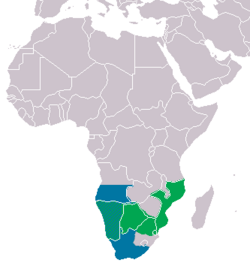Shield-nosed cobra
| Shield-nosed cobra | |
|---|---|

| |
| Aspidelaps scutatus, juvenile | |
| Scientific classification | |
| Domain: | Eukaryota |
| Kingdom: | Animalia |
| Phylum: | Chordata |
| Class: | Reptilia |
| Order: | Squamata |
| Suborder: | Serpentes |
| Family: | Elapidae |
| Genus: | Aspidelaps |
| Species: | A. scutatus
|
| Binomial name | |
| Aspidelaps scutatus (Smith, 1849)
| |

| |
range of A. lubricus range of A. scutatus
| |
| Synonyms[2] | |
| |
The shield-nosed cobra (Aspidelaps scutatus), also known commonly as the eastern shield-nose snake, is a species of venomous snake of the family Elapidae.[2] The species is native to southern Africa. There are three recognized subspecies.
Description
[edit]Adults of Aspidelaps scutatus have an average snout-to-vent length (SVL) of 63.5 cm (25.0 in). The dorsal scales are arranged in 21–25 rows at midbody, and they are keeled on the posterior portion of the body.[3]
Geographic range
[edit]The shield-nosed cobra is found in Botswana, Eswatini, Lesotho, Malawi, Mozambique, Namibia, South Africa, Zambia and Zimbabwe.[1]
Habitat
[edit]The preferred natural habitat of Aspidelaps scutatus is sandy-soiled savanna, at altitudes of 90–1,400 m (300–4,590 ft).[1]
In captivity
[edit]Aspidelaps scutatus can survive between 20 and 28 years in captivity, though this age is normally not attained in the wild due to predation, accidents, etc.[citation needed]
Venom
[edit]The species Aspidelaps scutatus is highly venomous, and its bite has caused at least one reported death of a human, despite its propensity to bite being somewhat low. The venom is highly neurotoxic. Symptoms include slurred speech, ptosis, and partial paralysis. No antivenin is available for this species. Any bite or spit-sprayed venom from any elapid snake should be treated as an urgent medical emergency.[3]
Behavior
[edit]Aspidelaps scutatus is fossorial. A specialized skull structure, along with the uniquely large rostral scale, make it very effective at digging and tunneling. [4] It is a nocturnal species.[1][3]
Diet
[edit]Aspidelaps scutatus preys upon suitably sized amphibians, lizards, snakes, and mammals.[3]
Reproduction
[edit]Aspidelaps scutatus is oviparous.[1][2] Clutch size is 4–10 eggs, and the female may stay with her eggs, coiled around them.[3]
Subspecies
[edit]Three subspecies are recognized as being valid, including the nominotypical subspecies.[2]
- Aspidelaps scutatus fulafulus (Bianconi, 1849)
- Aspidelaps scutatus intermedius Broadley, 1968
- Aspidelaps scutatus scutatus (A. Smith, 1849)
Nota bene: A trinomial authority in parentheses indicates that the subspecies was originally described in a genus other than Aspidelaps.
References
[edit]- ^ a b c d e Alexander, G.J.; Tolley, K.A. (2021). "Aspidelaps scutatus ". IUCN Red List of Threatened Species. 2021: e.T110168111A139743257. doi:10.2305/IUCN.UK.2021-2.RLTS.T110168111A139743257.en. Retrieved 14 August 2023.
- ^ a b c d Aspidelaps scutatus at the Reptarium.cz Reptile Database. Accessed 13 December 2016.
- ^ a b c d e Branch, Bill (2004). Field Guide to Snakes and other Reptiles of Southern Africa. Third Revised edition, Second impression. Sanibel Island Florida: Ralph Curtis Books. ISBN 0-88359-042-5. 399 pp., 112 color plates. (Aspidelaps scutatus, p. 104 + Plates 18, 26).
- ^ Deufel, Alexandra (2017). "Burrowing with a kinetic snout in a snake (Elapidae: Aspidelaps scutatus)". Journal of Morphology. 278 (12): 1706–1715. doi:10.1002/jmor.20743. ISSN 0362-2525.
Further reading
[edit]- Bianconi, G.G. (1849). "Lettera al dottore Filippo de-Filippi professore di zoologia a Torino sopra alcune nuove specie di rettili del Mozambico ". Nuovi Annali delle Scienze Naturali, Bologna, Serie Seconda. 10: 106–109. (Naja fula-fula, new species, pp. 108–109). (in Italian and Latin).
- Boulenger, G.A. (1896). Catalogue of the Snakes in the British Museum (Natural History). Volume III. Containing the Colubridæ (Opisthoglyphæ and Proteroglyphæ), Amblycephalidæ, and Viperidæ. London: Trustees of the British Museum (Natural History). (Taylor and Francis, printers). xiv + 727 pp. + Plates I–XXV. (Aspidelaps scutatus, p. 391).
- Broadley, D.G. (1968). "A revision of Aspidelaps scutatus (A. Smith) (Serpentes: Elapinae)". Arnoldia. 4 (2): 1–9. (Aspidelaps scutatus intermedius, new subspecies).
- Smith, A. (1849). Illustrations of the Zoology of South Africa; Consisting Chiefly of Figures and Descriptions of the Objects of Natural History Collected during an Expedition into the Interior of South Africa, in the Years 1834, 1835, and 1836; Fitted out by "The Cape of Good Hope Association for Exploring Central Africa:" Together with a Summary of African Zoology, and an Inquiry into the Geographical Ranges of Species in that Quarter of the Globe. Volume III. Reptilia. London: Lords Commissioners of her Majesty's Treasury. (Smith, Elder & Co., printers). 78 Plates, accompanied by unnumbered pages of text + Appendix, 28 pp. (Cyrtophis scutatus, new species, p. 22 in Appendix).

